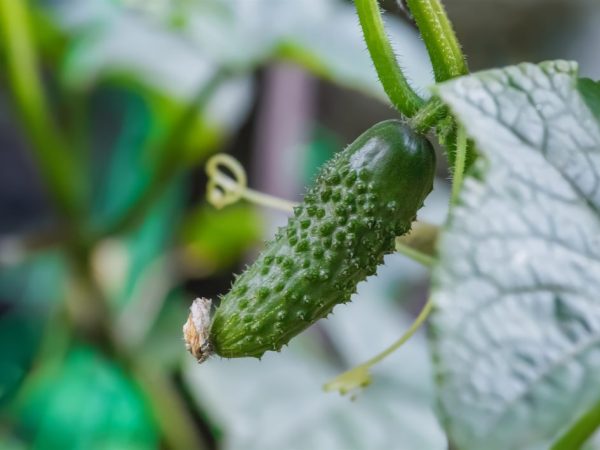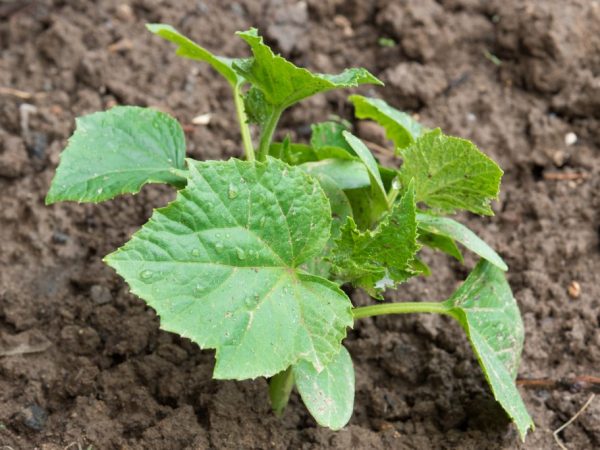Characteristics of Murashka cucumber
Cucumber Murashka is a hybrid of early cucumbers of Russian selection. The authorship of the hybrid belongs to the selection and seed company Gavrish. The crop was bred for cultivation in greenhouse conditions, but it shows good yields in open field conditions, and bears fruit even on balconies and window sills. The characteristic of the plant speaks of its many benefits. Recommended for cultivation in suburban and garden plots, small farms.

Characteristics of Murashka cucumber
Variety characteristic
Cucumber Goosebump F1 is self-pollinating. The first fruits are produced in 35-40 days from the emergence of shoots.
Description of Murashka cucumber:
- medium-sized bush, medium branching, indeterminate, covered with female flowers; lateral shoots are determinate, internodes are short; densely covered with leaves;
- leaves are green, medium in size, smooth, irregularly serrate;
- up to 4 fruits are tied in one bosom;
- fruits are cylindrical, covered with large tubercles, average weight - 100 g, length - 10-12 cm, diameter - 3-4 cm;
- the skin can be of different shades: from light green to dark, the color brightens from top to base;
- fruits are covered with black and thorny thorns;
- the neck is not long;
- the pulp is sweet and aromatic, there is no bitterness.
The crop gives up to 12 kg of yield from each m2. The variety is used fresh, but is best suited for harvesting for the winter. For fresh salads, it lacks juiciness.
F1 fruits are harvested in July and August. They last for a long time and do not lose their taste and presentation, even when the gardener did not have time to collect them in time.
Advantages and disadvantages
Cucumbers Goosebump F1 have a lot of advantages: they ripen early, have excellent taste and look aesthetically pleasing. The culture brings high and stable yields, is not afraid of most painful conditions and is unpretentious in care. It has practically no barren flowers, the fruits have no bitterness and are universal in use. The plant can be cultivated in open and closed ground, it has good immunity to powdery mildew and cladosporium. The plant is unpretentious and quickly recovers after adverse weather conditions.
The disadvantage is the need to grow crops in seedlings. Sowing seeds directly to a permanent place of growth will not allow you to achieve a good result. It is best to grow it in seedlings.
Planting cucumbers
Planting a crop is no different from planting other varieties of cucumbers. The only difference is that it is best to grow seedlings for an earlier harvest.
Seedlings or seeds are planted in open ground at the end of May. Earlier dates do not allow growing the crop: sprouts may die from the still unstable warm air temperature
Soil preparation
Cucumbers Goosebump F1 require a medium loamy soil through which air can freely penetrate.
You can lighten the soil in the following ways:
- Add humus (7-8 kg per m2) and sand (bucket per m2) to it.
- Use for f1 cucumbers the area where green manure plants (peas, mustard, phacelia, marigolds, etc.) grew before. The roots of these crops loosen the ground perfectly. In addition, after growing, their tops are used as mulch, which also improves the quality of the soil.
Such simple measures allow you to prepare a plot for growing cucumbers f1. Experienced gardeners do them all the time, and the cucumbers pay them good harvests.
Planting

Keep a distance when planting
Seeds are sown in seedling boxes or cups to a depth of 1.5-2 cm. The temperature in the greenhouse should be constant - about 25 ° C. When the first shoots appear, the temperature is lowered to 14-15 ° C. Seedlings are planted in open ground after the establishment of stable warm weather.
If seeds are sown directly into open ground, then its temperature should be at least 15 ° C. Sowing depth - 2-3 cm. Before sowing, the seed is sorted out, heated and hardened. Seeds are sown in May, later dates are not suitable, as the soil dries up and the yield will decrease. Cucumbers f1 are sown in rows, the distance between which is 60-70 cm. You can use a square-nesting scheme, then less time will be spent on processing row spacings. For each m2 of the garden there are 2-3 bushes in a row. On light soils, the seeds are deepened by 5-6 cm, on heavier soils - 3-4 cm.
For the first two weeks, the beds are covered with foil or agrofibre. After the frost has passed, the shelter is removed.
Care
The cultivation of this culture has some nuances. Novice vegetable growers should familiarize themselves with them.
The main stems of each bush are pinched at 6-7 leaves, the lateral shoots break off up to 40 cm. This contributes to the formation of a bush. Scientists have improved the variety, and it began to gain popularity among gardeners. Regular grooming results in good results.
Watering
Like all cucumbers, the crop requires regular watering. For irrigation, use warm water, for each m2 - at least 2 buckets. Sprinkler irrigation or drip irrigation is ideal.
But these types are very expensive, and not every vegetable grower can afford them. When using the hose, you must act carefully so that the roots of the culture are not exposed. The water jet should be under low pressure.
Fertilizer
The culture must be constantly fertilized. The first feeding is carried out 7-10 days after planting the seedlings. A solution of bird droppings or mullein is suitable for this.
After ten days, fertilizers are reapplied. Use a manure solution, add 1 tbsp for every 10 liters of liquid. l. nitroammophoska or superphosphate. For the third time, the plantings are fed with a complex preparation. After each root top dressing, the soil is thoroughly loosened. Weeds are removed as they grow.
Pest control
Cucumber Goosebump F1 is capricious. Culture attracts pathogens, and novice gardeners need to familiarize themselves with prevention and control measures.
Protect culture from diseases with special chemicals and folk methods. Let's list some of them:
- From powdery mildew, in addition to creating unfavorable conditions for the spread of fungal spores, drugs "Topaz", "Jet", "Quadris" will protect.
- Bordeaux mixture or "Quadris" serves as a prophylaxis of anthracnose.
- Cucumber mosaic treatment is carried out with "Aktara" or "Aktelikt".
- Spraying with skim milk will help with the development of green speckled or white mosaics.
- With angular leaf spot, a 1% solution of Bordeaux liquid will help.
- When the first signs of downy mildew appear, cultures are treated with Radomil Gold or Kuprosatom.
- The first signs of cladosporiosis are stopped with the help of copper oxychloride preparations.
- For the prevention of white rot and root rot of cucumbers, Fitosporin-M is used.
- For the prevention of melon aphids, a solution of ash and soap is used (2 glasses of ash and a spoonful of liquid soap are added to a bucket of liquid).
- Powdery mildew can be fought with Topaz.
Each of the diseases is easier to prevent than to cure. Proper care and timely prevention allows experienced summer residents to cope with any of the listed diseases.
Compliance with the listed recommendations allows you to achieve a good harvest and provide the whole family for the winter with tasty preparations from cucumbers of this variety. The gooseberry cucumber variety is an excellent choice for vegetable growers.


